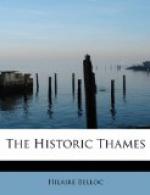Then there is also Radley: which begins as an exception, but fails. It was a manor of Abingdon, and after the Dissolution it fell a prey to that one of the Seymours who proved too dirty and too much even for his brother and was put to death in 1549. It passed for the moment, as we have seen several of these riverside manors do, into the hands of Mary. But upon her death Elizabeth bestowed it upon a certain Stonehouse, and the Stonehouses did come uncommonly near to founding a family that should endure. Nor can their tradition be said to have disappeared when the name changed and the manor passed to the nephew of the last Stonehouse, by name Bowyer. But Bowyer did not retain it. He gradually ruined himself: and it is amusing at this distance of time to learn that the cause of his ruin was the idea that coal underlay his property. Everyone knows what Radley since became: it was purchased by an enthusiast, and is now a school springing from his foundation.
Or consider the two Hinkseys opposite Oxford, both portions of Abingdon manors; they are granted in the general loot to two worthies bearing the names of Owen and Bridges: a doctor.
These were probably no more than vulgar speculators upon a premium—“Stags,” as we should say to-day—for a few years afterwards we find a Williams in possession of one of the Hinkseys; he is followed by the Perrots, and only quite late, and by purchase, do we come to the somewhat more dignified name of Harcourt. The other Hinksey, after still more varied adventures, ends up in the hands of the Berties, obscure south-country people who date from a rich Protestant marriage of the time.
Cholsey, again, with its immemorial traditions of unchanging ecclesiastical custom, receiving its priests in Saxon times from the Mont St. Michel upon the marches of Brittany, and later holding as a manor from the Abbot of Reading, remains with the Crown but a very few years. In 1555 Mary handed it over to that Sir Robert Englefield who was promptly attainted by her successor. It gets in the hands of the Knowleses, then of the Rich’s, and ends up with the family of Edwardes-seventeenth-century Welshmen, who, by a plan of wealthy marriages, became gentlemen, and have now for 100 years and more been peers, under the title of Kensington.
The mention of Sir Robert Englefield leads one to what is perhaps the best example in the whole Thames Valley of this perpetual chop and change in the holding of English land; that example is to be discovered at Pangbourne.
Pangbourne also was monastic; and the manor held, as did Cholsey, of Reading Abbey. In the race for the spoils Dudley clutched it in 1550. When he was beheaded, three years later, and it passed again to the Crown, Mary handed it (as she had handed Cholsey) to Sir Robert Englefield. His attainder followed. Within ten years it changes hands again. Elizabeth in 1563 gave it to her cofferer, a Mr Weldon. This personage struck no root, nor his son after him, for in 1613, while still some were alive who could remember the old custom and immemorial monastic lordship of the place, Weldon the younger sold it to a certain Davis.




